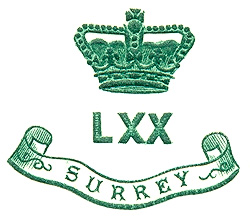 31st in China 1860,
70th Regiment in 19th Century
31st in China 1860,
70th Regiment in 19th Century
Formation of The East Surrey Regiment
The 31st Regiment in the China War of 1860
The next war in which Britain and France were allied was the China War of 1860. The 31st landed at Hong Kong in April, and four months later moved north to Pehtang where the formidable Taku Forts were located. The Allies attacked and after several days hard fighting the Taku Forts were captured. The 31st served for a while on the lines of communication before moving to Tientsin, where they were stationed until 1862, hostilities having ceased in October 1860. This was the last active service of the 31st before its amalgamation with the 70th Regiment in 1881.

The 70th Regiment in the 19th Century
In the years of peace that followed the ending of the Napoleonic War, the 70th served in Canada, the Mediterranean, the West Indies and Ireland. In January 1849 they were sent to India for the first time, and in their early years there suffered terribly from cholera. At Cawnpore in 1853, the Regiment buried two officers, 344 men and 136 women and children, and a further 90 men the following year, but after moving to Peshawar late in 1856, the health of the Regiment improved considerably.
 |
In 1857, the Indian Mutiny broke out and the 70th were engaged in various operations to disarm the native troops. A total of 523 rebels were killed at Peshawar before the Mutiny petered out. The Regiment served in several other stations in India before embarking for New Zealand in 1861.
When the 70th, arrived there in June 1861, the Maori tribes in North Island were in a state of insurrection. The Regiment took part in a number of skirmishes before peace was restored. The campaign, though not particularly arduous, caused a number of casualties to officers and men. The Regiment returned to England after 17 years abroad in the spring of 1866.
The stay of the 70th at home was to be short, for they returned to India in November 1871. The move up-country from Bombay was made by rail, the first time the Regiment had travelled by train. In 1875, the Regiment returned to Peshawar where it had been stationed 19 years previously. Three years later Britain declared war against Afghanistan, and the Regiment formed part of a column moving on Khandahar from Quetta via the Khojak Pass. The 70th were the first British regiment to enter Khandahar on 8th January 1879. During this short campaign, the last in which the 70th were to take part, the losses from enemy action were not great, but the troops suffered a good deal from extremes of heat and cold, and from inadequate administration in the mountainous country.
 |
| A badge of the 31st Huntingdonshire Regiment. |
 |
| A badge of the 70th Surrey Regiment. |
Formation of The East Surrey Regiment
On 1st July 1881, as a result of the Cardwell Reforms, the 31st amalgamated with the 70th Regiment to form The East Surrey Regiment. Thus the 70th returned to join its original progenitor, and Kingston, already the Depot of the 70th, was confirmed as the Depot Town of the amalgamated Regiment. The new Regiment adopted as its badge a combination of the Arms of Guildford and Kingston superimposed upon the Star of the Order of the Garter.
Related
